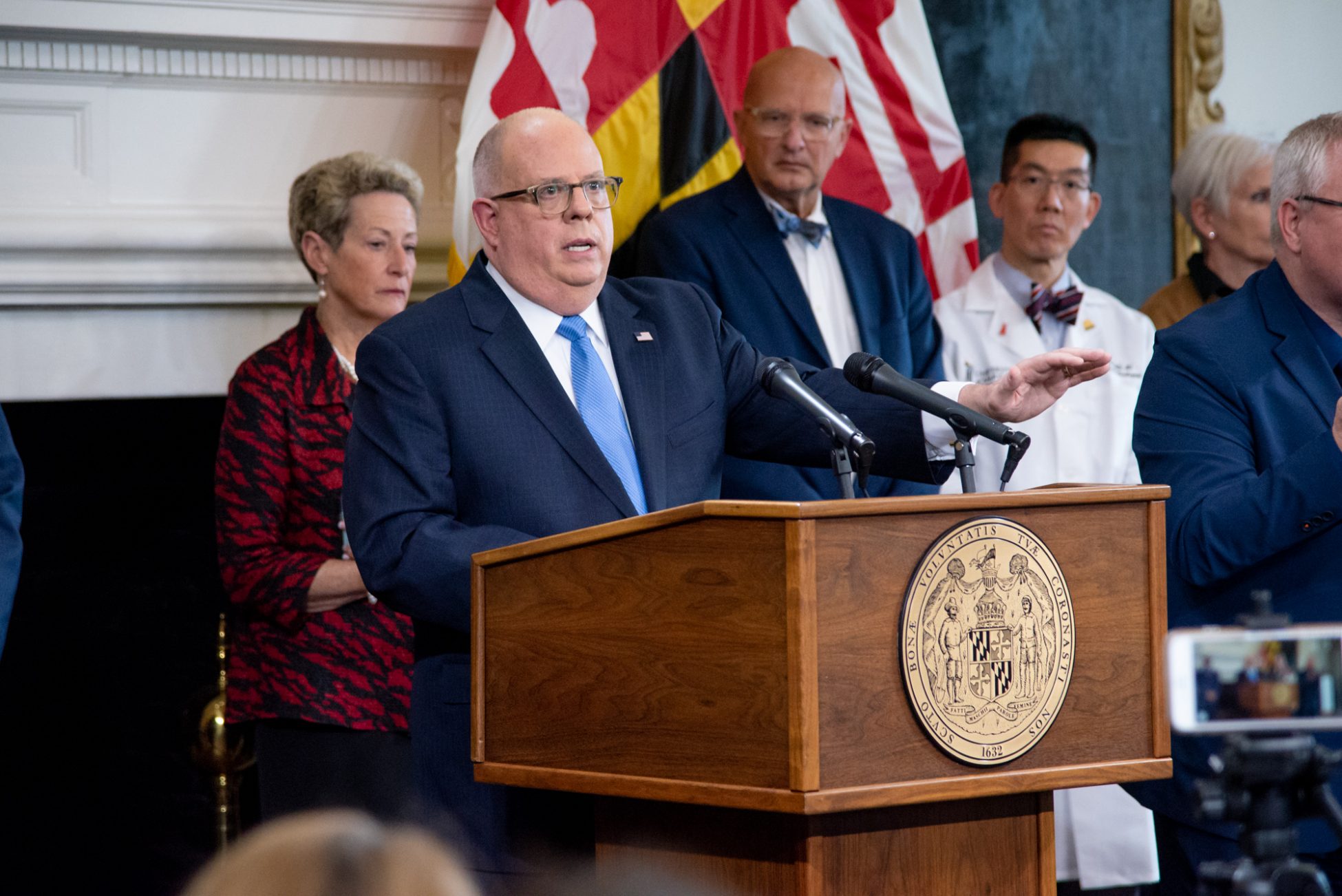About one month after ordering all non-essential businesses to be closed in Maryland, Gov. Larry Hogan unveiled a plan Friday detailing how operations will start resuming in the state, announcing some coronavirus-related restrictions could be lifted as soon as May.
Broken down into three stages, the plan will gradually reopen Maryland’s economy and ease back limits on social gatherings. However, at a press conference, Hogan emphasized it will only begin to unroll if the number of hospitalizations and deaths related to the virus continue to decline.
“We are watching these numbers very closely on a daily basis,” Hogan said. “When we start to see that downward trajectory, or a consistent plateauing of those metrics, that can put us in a position to consider lifting the stay at home order, and beginning our gradual, safe and effective recovery plan.”
As of now, Hogan said the state is not ready to lift social restrictions or unfreeze the economy — that will only come when the number of Marylanders hospitalized and admitted to the intensive care unit trends downward for at least 14 days.
These two statistics were still rising as of Friday, with the number hospitalized from the virus up by 141 in one 24-hour period. To this date, a confirmed 723 Marylanders have died from COVID-19, and just over 1,100 have been released from isolation.
And even when the thaw does occur, residents will need to practice social distancing and limit person-to-person contact, Hogan said. The wearing of cloth masks – mandated by executive order less than 10 days ago – will also continue to be the norm, at least for the near future, a doctor on the governor’s task force said.
The plan has no precise timeline or dates. And the roadmap’s design recognizes the reality that progress may backslide if new outbreaks occur.
But the governor held out the possibility the state could reopen as soon as “early May” if Maryland residents continue following social distancing guidelines, staying home and, crucially, if COVID-19 statistics either hold steady or decline.
[Read more: Horns blaring, demonstrators flock to Annapolis to condemn stay-at-home order]
The roadmap, which was fully released to the public Friday, stresses that its details may change depending on how the outbreak evolves in the coming weeks and months. However, as currently outlined, Stage 1 brings with it the potential for immediate relief.
According to the plan, it would signal the reopening of certain small businesses, along with ending the stay-at-home order – instead replacing the mandate with guidance encouraging Marylanders to voluntarily do so. Lower-risk group activities – primarily those that take place outdoors like golf and fishing – could resume, Hogan said.
Certain changes would be dictated on a county-by-county basis.
Elective outpatient procedures could resume in counties with low concentrations of coronavirus cases. Counties will have the option to reopen locations such as parks, playgrounds and libraries if it can be done safely, Hogan said.
If, during the first stage of the plan, the state does not see a spike in the number of virus transmissions, associated deaths or hospitalizations requiring intensive care, the state will be in a position to continue lifting restrictions, Hogan said.
At the second stage, businesses such as bars and restaurants could reopen with certain restrictions. Many have been closed since the governor’s March 12 executive order. Indoor religious gatherings could begin again, with certain safety restrictions such as a cap on attendance. Public transport schedules could start resuming similar to a normal schedule at this time, Hogan said.
The third and final stage marks a squinting approximation of a return to normal, with a bevy of asterisks.
Larger social gatherings could be allowed at this time, and entertainment venues could begin admitting customers again, Hogan said. Nursing homes — the sites of vast numbers of coronavirus cases — could see some restrictions lifting at a later point during this stage.
The plan’s details are tentative, reflecting the fact that the outbreak’s future remains uncertain.
“This document is a roadmap, not a calendar,” the plan’s text reads.
At each step, the plan calls for keeping an eye out for “stop signs” – indications that certain restriction easements are triggering new outbreaks. If this scenario occurs, there is a chance progress towards ending the economic pain grinds to a halt.
If there is an “unexpected increase” in hospitalizations or “significant outbreaks of community transmission” — which the roadmap clarifies is not just a cluster of cases in certain at-risk communities — or if Marylanders start ignoring social distancing guidelines, easements might even be reversed.
“If we try to rush this, and if we don’t do it in a thoughtful and responsible way, it could cause a rebound of the virus which could deep in the economic crisis prolong the fiscal problems and slow our economic recovery,” Hogan said at the press conference.
[Read more: Maryland Gov. Hogan orders face coverings in retail stores, transit systems]
Alongside the unveiling of the recovery roadmap, Hogan announced new additions to his pandemic team, which was previously composed almost entirely of public health experts and doctors.
The group, called the governor’s “coronavirus recovery team,” will now feature several members from the business community, including Under Armor founder and University of Maryland alumnus, Kevin Plank.
The team joins a cadre of industry-specific advisory groups tasked with determining how businesses in the state can reopen while ensuring the safety of employees, customers and the general public, Hogan said.
At the conference, Dr. Tom Inglesby, director of the Center for Health Security at Johns Hopkins Bloomberg School of Public Health, said the fight against COVID-19 will remain an ongoing effort until a vaccine is produced and enough people gain immunity to the virus, which greatly reduces the likelihood of another outbreak.
“Even when the state does begin to reopen it will be critical for the public to know that its own individual efforts will still be very important,” he said. “All of our collective actions and decisions will either slow this virus down or they will speed up the spread.”
A businessman himself, Hogan said there is “absolutely nothing more important” than getting residents working again and reopening businesses. He promised his administration would be transparent with the public as the state works toward recovery.
“I want to stress that even as we begin our recovery, we won’t be able to just flip a switch. Unfortunately, life is not going to just immediately go back to normal,” Hogan said.“Together we are going to defeat this deadly virus. And together, the state of Maryland will return stronger and better than ever.”



